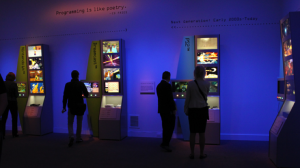Is there such a thing as popular art? The term “popular” leaves a sour taste in the mouths of those trying to win respect from established institutions that seem to determine artistic merit. These institutions are towering monoliths that surround themselves with an agonizingly enticing air of prestige. I’m talking about museums, which are the be-all-end-all of the art world. In an ever-changing world, museums are racing to catch up, compelled by a need to compete with other cultural and entertainment destinations. While some lament this change, worried these institutions are pandering to the public, others believe museums are not changing fast enough to catch up with the new sensibility, which most recently includes a move to accept videogames as art. Most agree, however, that museums are a fundamental aspect of the art community and rely heavily on their expertise and validation.
There’s nothing controversial about declaring painting or sculpture as art. Film has made its way into this category as well, though not all films. For example, I feel confident in dismissing the 2015 Fantastic Four film (aka Fant4stic) as art for only its aimless plot that deteriorates into sub-par CGI and mindless fight scenes. On the other hand, year Amelie, with its super-saturated color palette and whimsical characterization, is a compelling example of falling in the category of art. The word ‘art’ is such a vague and complex a term, that in reality it is more of a sliding scale than a declaration. The distinction between art and everything else in the general, societal understanding falls under the category of discourse, which lacks concrete definition and relies on a slew of context that arrives at some fuzzy common agreement. (If you want to know more about discourse, I suggest locating and trying to decipher pages and pages of Michael Foucault’s rambling, inarticulate explanations strewn across various works of his). If Amelie is not artistic enough, perhaps an experimental film such as Last Year at Mariendbad would fit.
(still from Last Year at Mariendbad)
My point is, not all film is art, but film that thoughtfully engages with emotion, style, or purposefully departs from convention could be worthy of the title. Describing the medium of film as art collectively seems heretical considering that you would be forcing A Single Man into the same category as Ghost Rider. It seems unfair to think any painting, whether it be a Monet or a three-year-old’s, could be universally called art, but mindless films are left high and dry. Practically, though, people want to draw a line somewhere, otherwise anything could be considered art, which would threaten countless egos and the prestige of museums.
Perhaps not all film is collectively considered art because it is one of the newer mediums to be introduced in a new sensibility. In George Cotkin’s book A Feast of Excess, he discusses the New Sensibility that emerged in the 1950s, which “was about excess, exaggeration, pushing limits, embracing the popular, and going too far in style and spirit” (7). This New Sensibility (with capital letters) is a term that may be referring to a specific movement, but the concept can be constantly applied to an ever-changing art world. The New Sensibility pushed the boundaries of art to the extreme, with pieces such as John Cage’s 4’33”, which used music to push the boundaries of minimalism. Though a current new sensibility may not involve such excess, it is questioning the structure of the heart of art infrastructure: the museum. The current new sensibility, still forming today, questions the function of the museum and what is allowed inside.
Videogames may be the newest medium aggressively forcing itself into the art world, which is how every new concept gets there. In Paolo Pedercini’s manifesto, The Great Art Upgrade, originally presented orally in 2013, Pedercini adds his two cents (or three judging by the length of his impassioned speech) to the not-so-old debate about the relationship of videogames to art. He describes the vigor with which the gaming community has recently been trying, and sometimes succeeding, to get society to admit that video games are art. The “cycle of shame and pride” that describes the fight to declare games is birthing “a new sensibility,” as games are more and more getting a foothold in institutions (Pedercini). Pedercini does not hide his exasperation with the game industry and fans, however, because they measure success by how museums have begun to recognize, showcase, or collect videogames. The perspective to most seems to be that the metric of the museum is the final frontier, and that there is some divine institution that determines what art is. The truth is much more complicated, but this oversimplification is more appealing than an ongoing struggle.
Pedercini sites the 2012 Smithsonian exhibition, “The Art of Videogames,” as one of the celebrated advancement of videogame status. But he also criticizes, saying that “[g]ame people were too busy celebrating this recognition to wonder whether or not this was a just populist publicity stunt to refresh the museum’s image and the industry’s. The show was in fact “generously” supported by Entertainment Software Association.” This exhibition was not only paid for by a major publisher and supporter of popular games, but Pedercini accuses the Museum of using videogames as a marketing tool rather than genuine interest in their artistic merit. While the industry was trying to become more elite and respected, the Smithsonian was attempting to appeal to a younger, more radical crowd, which is the recent trend.
(from the Smithsonian exhibition “The Art of Videogames”)
In Matti Bunzl’s book In Search of Lost Avant Guarde, he dives deep into the inner working of Chicago’s MCA to reveal hidden tensions between the curators, the marketing team, and the educational programmers. More and more the marketing and fundraising division of the museum get the final say because it comes down to money and visitation to stay afloat (Benzl). To compete with the entertainment—movie theaters, shopping, and restaurants—for people’s time, museums are forced to sacrifice novelty for safer, more well-funded options—such as the Smithsonian’s “The Art of Videogames” exhibition. This exhibition is in keeping with museum’s attempts to become destination and events rather than simply presenters and protectors of art. Northwestern’s Block museum offers discussions and performative artwork open to the public; experiences that offer a chance to engage in conversation with an artist in ways that walking around a gallery cannot. You could attribute this change to the lamented loss of patience that plagues humanity today, but nostalgia for an elusive simpler time has and always will be present. The fact of the matter is that museums have always evolved with the times, and though some criticize this change, others (like video games as art advocates), don’t think museums are changing fast enough.
In the 1940s, complaints about modern art museums arose, accusing them of showing work that wasn’t contemporary enough (Claire Bishop, 12). [T]he Institute of Contemporary Arts in London was founded in 1947, opting to show temporary exhibitions rather than building up a permanent collection, as did many similarly titled venues.” This new perspective on a museum—striving to show only contemporary art—was a direct reaction to a movement, and was made to draw in the audience that demanded it. Museums could ignore societal shifts and remain absolute in old beliefs, but one period’s old ideas were another’s radical shifts. Resisting change in museums, as with anything else, will only result in obsolitism, which would be death to an institution that strives for viewership. Art is displayed to be viewed, so there will always be a conversation between museums and the changing perspectives of their potential audience. The push to install videogames into museum galleries is no different than the push for a purer contemporaneity uninhibited by the past.
However, even if museums are just barely beginning to acknowledge videogames, they are still not designed to display them. Pursuing a gallery involves walking around and perhaps very occasionally sitting on a bench if one is supplied. Videogames often require a longer commitment that few would be willing to engage with if they had to stand in one place for extended periods of time. Pedercini elaborates in his manifesto, “We may need to bring some couches, snacks and drinks in the museum. Because you just can’t play Cart Life in 5 minutes while standing.” Perhaps this is why “only 5 among the 80 chosen titles were actually playable in the exhibition” (Pedercini).
Currently, the struggle for artistic validation is best exemplified by the push for video game recognition, and museums have always been the most concrete elevation of a medium. Once you’re in a museum, you’ve “made it,” but this glorification of museums is misguided and perpetuated by a wealthy elite. Anything that does not exist within the structure of a cultural system enabled by the wealthy is too common, too popular to be highly regarded. These discards of the upper class fall to the entertainment industry to distribute. Perhaps on one side of the scale you have entertainment and on the other lies art (and the museum). Art and entertainment both fall under culture, but only art is cultured. Though these boundaries are abstract creations of society, they lie in that dangerous realm of a discourse, which takes years of resistance to unravel. Controversial art is often the most interesting, so though this pushback can be frustrating to some, it in itself is validating. Pedercini concludes his impassioned manifesto, “we cannot have an art history of games without an art criticism of games,” which gives me hope that this current struggle is just the beginning of a new sensibility that’s here to stay.
Image sources:
Last year at Marienbad: https://mountainx.com/movies/reviews/last-year-at-marienbad/
Smithsonian exhibition “the Art of Videogames”: http://www.molleindustria.org/blog/the-great-art-upgrade/
(featured image) Cory Arcangel’s game modification-Clouds: http://www.coryarcangel.com/things-i-made/2002-001-super-mario-clouds



6,124 Comments
iing nih bos senggol dong sobat777
hallo bosku semua sobat 777
smart phones have revolutionized the way we live, offering a powerful blend of communication, entertainment, and productivity tools in a single, compact device.
We offer 24/7 companionship care tailored to meet each patient’s unique needs. Contact us at 020 7101 3125 for personalized support and companionship.
I have to convey my respect for your kindness for all those that require guidance on this one field. Your special commitment to passing the solution up and down has been incredibly functional and has continually empowered most people just like me to achieve their dreams. Your amazing insightful information entails much to me and especially to my peers. Thanks a ton; from all of us. Katsu5
semangat ya kerjanya LOGIN WARKOPKIU
visit my site i have good ideas for you https://bsspoke.co.uk/collections/sofas
Thank you because you have been willing to share information with us. we will always appreciate all you have done here because I know you are very concerned with our. bandar slot gacor
mau makan apa sobat777
This is certainly interesting posting plus i spend time to read simple things the following posting. your website is definitely brilliant and you simply currently have fine team in the site. awesome spreading stay the best. Luxury338